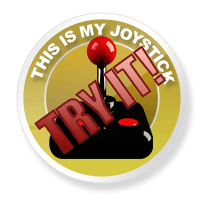Reviews
Kid Icarus: Uprising
May 1, 2012, Author: Andy Corrigan
Ahhh, Kid Icarus. While I can’t admit to have ever played the original NES game (except for recently from the eStore), I certainly have many a fond childhood memory of the Gameboy sequel, tag-lined ‘Of Myths and Monsters’. So, when I heard that there was some fan pressure on Nintendo to resurrect the franchise after a twenty years-plus hiatus (his Smash Brothers appearance not withstanding), I was fully behind the movement.
Nintendo eventually listened, caved and commissioned Project Sora to finally bring the fans’ dream to life with Kid Icarus: Uprising. We were expecting great things. I was expecting great things.
What I wasn’t expecting, bearing in mind that the original games were side-scrolling platformers, was that resurrection to take the form of a partly on-rails shooter…
Hell on Earth
The human world is being heavily attacked, and it is the snake-haired Medusa (yes, that Medusa) leading the charge. In retaliation, the goddess of the realm, Palutena, enlists the help of plucky young angel Pit, to strike back as quickly as possible. Using all the help he can get, Pit must defeat all manner of famous mythological beasts (and even aliens) to save the human world from total enslavement by the underworld.
While light-hearted, breezy and bubbling with charm, the story is a bit, well… blegh. It’s not utterly terrible by any stretch, don’t get me wrong. There’s enough twists and turns that it should just about take you through to the end, but I felt it could have been so much more. Charm and humour go a long way, but I didn’t feel that alone was enough to make the game really stand out or give me any reason to care about anything happening.
That said, there was the occasional commentary on the ethics of real war, which took me by surprise. There was a point early on that highlights this perfectly, where on his way to a boss’s castle, Pit takes in the sights of a human town being bombarded. Here he stops to question Palutena’s orders, desperately wanting to intervene and help the humans afflicted. She reminds him to look at the bigger picture. People may be dying below him, but by targeting the boss he will save far more lives than the handful he would help by delaying his mission.
It’s a bizarre, real-world moment in what is an otherwise light-hearted, and frankly, child-friendly game. I’m still not entirely sure of what I make of these elements or where their value sits with the rest of the game, but they’re there every so often.
The padding around the rest of the story is brilliant, though. The dialogue, where the characters banter and converse between themselves is wittily written, with fun jokes and even the occasional smattering of innuendo. The cast appear blissfully aware that they’re in a video-game and one that’s in Nintendo’s catalogue, judging by some of the references they make.
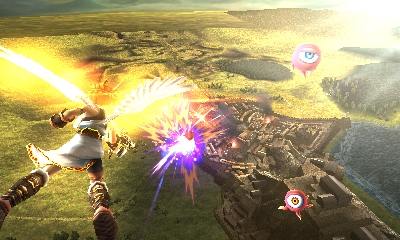
Take to the skies!
Hand cramps
Uprising sees two very distinct variations on gameplay, but they both follow the same core principles.
In the flight sections that open most chapters, the game immediately brings about memories of Child of Eden and Star Fox, and for more than a couple of reasons. The speed and flight path of Pit is always predetermined (although you get to choose a route occasionally), while it’s up to you to move him around the screen to dodge attacks and obstacles with the analogue stick, pressing the Left shoulder button to fire, while aiming the target reticule with the stylus.
Enemies enter the screen from all angles and in great numbers too, in what is essentially a fast and frantic shooting gallery. Should you be overwhelmed and find yourself taking too much damage, you can fire out a Child of Eden-style smart bomb that will temporarily clear the screen of all enemies to buy you some breathing space. You have two available at any one time, and they’ll recharge as you to continue to deal out the damage.
When things hit the ground, the game offers more control of Pit, allowing for some light exploration on an otherwise linear path, but it plays a little awkwardly thanks to the control schemes.
You move Pit around with the Circle Pad as you’d expect, with a tap and hold initiating a dash, while turning and aiming is all done with the stylus. If you swipe the screen, Pit will turn with the exact amount of pressure applied, so a full sweep will see him do a 180, and half swipes will turn him slightly left or right. The smart bombs are disabled in this mode, but you still have a trick up your sleeve; when enemies are close, tapping the attack button will see Pit perform a powerful mêlée attack.
You can also utilise the powers in this mode, the icons of which appear along the bottom of the touchscreen, almost MMO style, allowing you quick access in the midst of combat. The only initial power at your disposal is Health Regeneration, until you collect and equip more abilities. In these stretches, health is otherwise regenerated in by collecting food from fallen enemies; how delightfully old school…
As fun as it can be in both modes of gameplay, repetition sets in pretty quickly, with all chapters following the same predictable structure. You fly for a bit, land, navigate a castle layout and then take on the boss. Rinse and repeat. The boss fights also nearly all follow the same attack strategy too. Shoot and run sideways. If you’re lucky, you might have to target certain weak points or get in close to hit them with a mêlée attack… If you’re lucky…
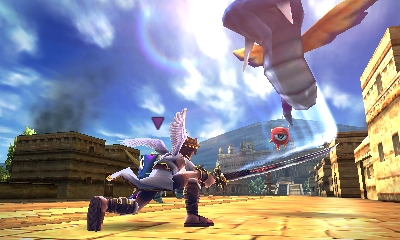
The land sections will cripple you.
The repetition isn’t the only painful aspect, as it has to be said that the controls are… uncomfortable. With most of the action done on the left-hand side of the console, and your right hand not even holding the console at all, you will likely feel some pain on extended plays, especially from the on-ground sections. The mere fact that Nintendo felt that they had to include a 3DS stand to help ease potential RSI says it all, despite the fact it doesn’t really help at all and completely misses the point of owning a handheld console in the first place.
Plugging the console into the Circle Pad Pro really doesn’t aid things either, only offering control of Pit’s movement on the right stick for southpaws. The obvious route to aid comfort here would have been to move aiming away from the touchscreen and put it on the right stick; the way the majority of players would find the natural method to play, yet it’s bizarrely not an option.
The game does a lot of things right, though. The mechanics are fun in short blasts thanks to its arcade style, and there is some depth to be found to help pad out the experience. During gameplay, for example, with every enemy shot down, you’ll acquire some Hearts (the amount of which determined by the difficulty you choose before each level). These hearts act as the game’s currency, and can be spent in-between levels on new weapons and items. There are hundreds of weapons, with bows, cannons and claws among their types, each with their own value and uses in mêlée and long-range combat.
You’ll also collect plenty of weaponry and new powers during gameplay by defeating certain enemies or by crossing off prerequisites from the ‘Treasure Hunt’ grids. Unwanted weapons can be exchanged for hearts or you can fuse them with one another to create newer, more powerful weapons. This will only get you so far though, as the best weapons can only come from ramping up the difficulty.
Powers come in a huge variety of flavours, from temporary passive abilities in health regeneration or increased armour, to additional weapons such as mines or jump-pads. To create your power loadout in-between rounds, you have to fit multiple powers into a small grid. Each individual power takes up varying amounts of squares and they come in different shapes, so you’d better get those Tetris skills brushed up.
Lastly, there is also a very limited AR feature. You get a handful of cards bundled with the game and as typical with AR, you can place their associated character on any real-world surface you fancy to take photos and such, but you also bag 100 hearts with each one you register. You can also make them do battle by facing the cards together but unfortunately, it’s nowhere near as interesting as it sounds as there’s no actual game to play here. It could have been a revolutionary way to mix card games, such as Pokemon or Magic, with video-games, encouraging people to build decks for use with their console systems.
Under normal circumstances, it would have been totally unfair of me to judge the game for the things it doesn’t do, but seeing as you can freely source more Kid Icarus AR cards (from Club Nintendo for example, and I got a pack with Official Nintendo Magazine), it’s easy to see that they could have done so much more with the system. It’s a wonder they even bothered producing more cards if there’s no real reward for acquiring them. You can’t do anything but see the characters fight for your own delight, and trust me, that novelty wears off in seconds.
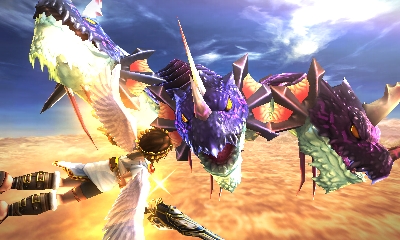
The boss fights are repetitive, if impressive-looking.
Heavenly body
If there is one aspect that I really enjoyed about Kid Icarus, it’s in the general design. The characters on the bottom screen during dialogue are drawn cutely in their anime styling, while everything in the actual game world is distinctly Nintendo. The enemies especially, considering some are ripped right out of other Nintendo titles.
The landscapes and backdrops deserve special mention as they look gorgeous, particularly in flight sections. Early on, under-siege towns are ablaze against lush, grassy fields, and lovely water effects help to provide a serene beauty amongst the chaos. Throw in castles, deserts, even spaceship interiors (with a little more than a hint of Star Fox about them), and you’ll a find a decent amount of variety.
There’s a lovely old-school feel too, which acts as part of the game’s self-aware nature. When one of the characters introduces you to a new enemy, it shows them in their old 8bit form on the screen below as a precursor, and when you die, you’ll be treated to a true NES font on the continue screen. This is a game that knows and respects its heritage, visually at least.
With all the great visual touches, it’s a shame that the 3D effect comes across so disappointingly. It’s very hit and miss, looking great in the few short moments that could be described as ‘cut-scenes’, but in the hustle of gameplay, the effect gets a bit lost.
Are angels singing?
I have to say that I loved the musical score on offer. It’s a classy affair, with arrangements that reminded me heavily of Zelda, and hell, even Skyrim at times. You’ll be treated to the occasional blast from the past too, with classic chip-tune tracks that somehow fit against the game’s many running themes.
There is a lot of dialogue too, which takes place between all the characters as you play. While there’s nothing inherently wrong with the voice acting or the dialogue itself, it’s the sheer amount of it that plays over the top of everything you do, which is both overwhelming and distracting. Imagine trying to read a book and having someone loudly talking over the top of you for the whole time. That’s almost how it feels.
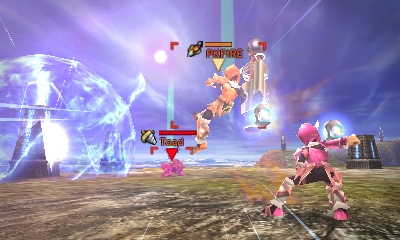
The multiplayer is way too messy to be any fun.
Pit team
You have two online multiplayer modes to help bolster longevity, but unfortunately both are uninspired, extremely messy, and make use of the RSI-tastic ground mechanics from the solo campaign.
In Light vs. Dark, two teams of three battle it out until the opposition’s health bar is depleted entirely. When that happens, the player killed at that point will regenerate as Pit and must retaliate on his lonesome. The winner is decided when either team’s Pit is defeated. The other mode is simply a six player free-for-all in the same vein.
The main problem here is that the unaltered game mechanics really don’t lend themselves to the ebb and flow of multiplayer; too quick and too roughly implemented to lead to a genuinely compelling experience. I certainly applaud the decision in carrying the player’s weapons and powers over from the main game. However, with all the hugely explosive effects flying across the screen at the same time, it becomes overly cluttered, making it difficult to tell who’s hitting what.
Throw in the shitty controls, and it’s far too frustrating to be even remotely enjoyable.
The Pits?
Kid Icarus: Uprising is certainly a polished game with fast-paced action, witty dialogue and some lovely design, but it’s also deeply repetitive and physically painful to play thanks to its uncompromising control scheme. A flawed multiplayer component and an undercooked AR system just aren’t enough to push the game beyond anything but an occasional distraction.
You’re left with a game that can be fun in short blasts, but nothing more.
Platforms: 3DS | Tagged Cerberus, Child of Eden, Hades, Kid Icarus, Kid Icarus Uprising, Medusa, Palutena, Pit, Pittoo, Project Sora, Shooter, Star Fox


